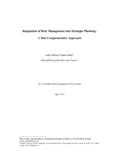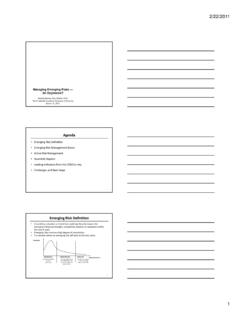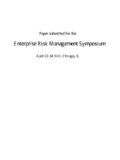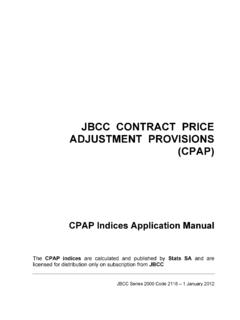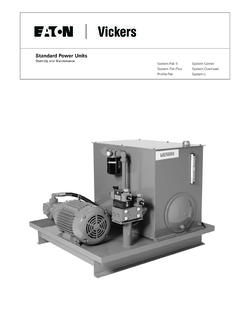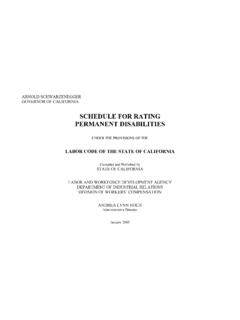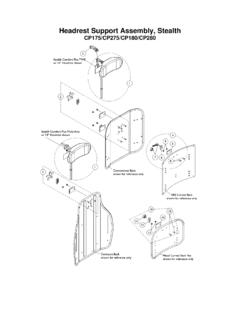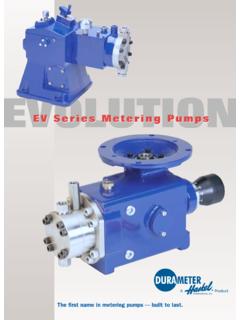Transcription of Introduction to Solvency II SCR Standard Formula …
1 Introduction to Solvency II SCR Standard Formula for Market Risk Erik Thoren 11 June 2015 Agenda Introduction to Solvency II Market risk module Asset allocation considerations Page 2 Introduction to Solvency II Introduction to Solvency II Three pillar structure Technical provisions Own funds Minimum Capital Requirement (MCR) Solvency Capital Requirement (SCR) SCR internal model approval Own Risk and Solvency Assessment Risk management Governance Reviewed by supervisor Disclosure Solvency and financial condition report Report to supervisor Market discipline Pillar 1 Pillar 3 Pillar 2 Page 4 Introduction to Solvency II SCR and MCR calculation approach SCR one-year Value at Risk (VaR) measure Enables insurer to withstand significant loss Accounts for several separate risks Standard Formula / Internal Model, or a combination of both (Partial Internal Model) MCR Solvency II has a minimum capital requirement Represents lowest acceptable capital level Corridor of 25% - 45% of total SCR Non-coverage of MCR triggers supervisory intervention *Discount rate used in BEL calculation may include matching adjustment or volatility adjustment Assets ($200) Free assets ($50) MCR ($20) Risk margin ($10) BEL ($90) Own funds ($100) SCR ($50) Technical provisions ($100) Pillar 1 balance sheet Page 5 Introduction to Solvency II SCR basic concept.
2 Shock approach MV Liabilities MV Assets NAV MV Liabilities MV Assets NAV Normal conditions (best estimate + risk margin) Stressed conditions ( percentile) NAV NAV Solvency Capital Requirement (SCR) MV liabilities MV assets Basic own funds MV Liabilities MV Assets SCR can be described as the change of basic own funds in a shock scenario Basic own funds Basic own funds Basic own funds Page 6 Introduction to Solvency II Overview of SCR Standard Formula Comprises individual risk modules, aggregated using correlation matrices Each of the risks modules will be calibrated with a confidence level over a one-year period , capital held for the possibility of a 1 in 200- year event happening in 12 months Same design and specifications for risk modules used for all companies SCR is calculated on solo entity level and group level separately (group level usually based on the consolidated balance sheet)
3 The Standard Formula is likely to be required for a number of reasons Page 7 = included in the adjustment for loss absorbing capacity of technical provisions of future profit sharing Adj Operational Risk Basic SCR SLT Health Mortality Longevity Disability / Morbidity Lapse Expenses Revision Interest rate Equity Property Spread Currency Con - centration Non-SLT health Premium reserve Lapse Health CAT Mortality Longevity Disability/ Morbidity Lapse Expenses Revision Premium Reserve Lapse Market Health Default Life Non - Life Intangibles SCR CAT CAT Market risk module Market risk module Overview Page 9 Interest rate Equity Property Spread Currency Concentration Market Risk Interest rate Equity Property Spread Concentration Currency Interest rate 1 A A A 0 Equity A 1 0 Property A 1 0 Spread A 1 0 Concentration 0 0 0 0 1 0 Currency 0 1 Market risk module aggregation = , A = 0 ( ) where the capital requirement for interest rate risk is given by an upward (downward) shock in the interest rate term structure Risk definition Risk of loss or of adverse change in the financial situation resulting, directly or indirectly, from fluctuations in the level and in the volatility of market prices of assets, liabilities and financial instruments.
4 Summary of approach Modular-based approach Correlation matrix to aggregate components Market risk module Interest rate risk Page 10 Risk definition Risk that the value of an asset or liability will change due to a change in term structure of interest rates or interest rate volatility. Summary of approach Instantaneous increase/decrease to basic risk-free interest rates for each currency at different maturities (shown at right). Capital requirement equals the larger of the sum, over all currencies, of the capital requirements for the risk of an increase or decrease in the term structure of interest rates. Maturity in (years) Increases Decreases 1 70% 75% 2 70% 65% 3 64% 56% 4 59% 50% 5 55% 46% 6 52% 42% 7 49% 39% 8 47% 36% 9 44% 33% 10 42% 31% 11 39% 30% 12 37% 29% 13 35% 28% 14 34% 28% 15 33% 27% 16 31% 28% 17 30% 28% 18 29% 28% 19 27% 29% 20 26% 29% 90 20% 20% Technicalities/practicalities Interest rates also directly affect the value of liability cash flows, as the present value of cash flows is dependent on the yield a riskless investment can achieve up to the time the cash flow is expected.
5 Rate increases shall be at least 1% in absolute terms. No rate decreases shall be applied where rates are negative. For maturities not specified in the table at right, the value of the increase/ decrease shall be linearly interpolated. For maturities shorter than one year, the increase shall be 70% and the decrease shall be 75%. For maturities longer than 90 years, the increase/decrease shall be 20%. Market risk module Equity risk Page 11 Risk definition Risk that the value of an asset or liability will change due to fluctuations in the level or volatility of the market prices for equities. Summary of approach Classify equities as Type 1 or Type 2 Type 1 Equities listed in regulated markets in the countries that are members of the EEA or OECD Type 2 (Other equities) Equities listed only in emerging markets, non-listed equity, hedge funds and any other investments not included elsewhere in the market risk module Instantaneous decrease based on type, symmetric adjustment and potentially other considerations Base shock of and for Type 1 and Type 2, respectively Strategic participation or duration-based equity approaches may instead apply (22% shock) Transitional measure may instead apply (22% shock grading to full stress over time) Symmetric adjustment included to avoid pro-cyclical effects of regulatory requirements (+ as of 12/31/13)
6 Increases/decreases shock based on current index value compared with its average over the last three years Calculation Formula : Technicalities/practicalities Market risk module Property risk Page 12 Risk definition Risk that arises as a result of sensitivity of assets, liabilities and financial investments to the level or volatility of market prices of property. Immediate effect on the net value of asset and liabilities expected in the event of an instantaneous decrease of 25% in the value of investments in real estate. )0;|max(shockpropertyNAVM ktprop Summary of approach The following are considered to be property: Land, buildings, immovable-property rights Property investment for the own use of the insurance undertaking Investment in real estate through collective investment undertakings, or other investments packaged as funds.
7 This should be done via the look-through approach. Investment in a company engaged in real estate management, or investment in a company engaged in real estate project development or similar activities are excluded from property risk and are included under equity risk. Calculation Formula : Technicalities/practicalities Market risk module Spread risk Page 13 Risk definition Risk that arises from the sensitivity of the value of assets and liabilities to changes in the level or in the volatility of credit spreads over the risk-free interest rate term structure Summary of approach Classify source of spread risk (sub-module for each) Bonds and loans (other than residential mortgage loans) Securitizations Credit derivatives (such as CDSes and TRSes) Apply methodology specific to source No diversification between components Bonds and loans capital charge = MV * risk factor (which is based on duration and credit quality) Risk factor stress may be impacted by availability of collateral, issuer ( , EEA sovereign)
8 Securitizations capital charge = MV * modified duration * risk factor (which is based on type and rating) Classified as Type 1, Type 2 and Re-securitizations Credit derivative capital charge = max (loss in BOF from instantaneous absolute increase in credit spread of underlying; loss in BOF from instantaneous relative decrease of 75% of credit spread of underlying) Magnitude of spread widening depends on credit rating Technicalities / practicalities cdnuritisatiobondsspreadSCRSCRSCRSCR secMarket risk module Currency risk Page 14 Risk definition Risk that arises from changes in the level or volatility of currency exchange rates Summary of approach For each foreign currency, the contribution to the capital requirement is determined as the maximum of the currency up-shock and the currency down-shock relative to the local currency Technicalities/practicalities Shocks up and down are 25% and (25%)
9 , respectively Factors can be reduced for currencies pegged to Euro The local currency is the currency in which the undertaking prepares its financial statements. All of the participant's individual currency positions and its investment policy ( , hedging arrangements, gearing, etc.) should be taken into account Includes any investment in foreign instruments where the currency risk is not hedged. Investments in listed equity should be assumed to be sensitive to the currency of its main listing. Non-listed equity and property should be assumed to be sensitive to the currency of its location Market risk module Concentration risk Page 15 Risk definition Risk that arises from large investment in individual counterparties and single name exposures. Summary of approach Determine excess exposure per single name exposure (XS_i) Determine risk concentration requirement per single name exposure (Conc_i), which is the loss in basic own funds caused by an instantaneous decrease in the value of assets corresponding to single name exposure i Aggregate across single name exposures (SCR_conc)
10 Technicalities/practicalities _ = Total exposure at default to single name i out of assets less counterparties with _ = 0 Assets = Total value of all assets held by the undertaking with some exclusions _ = Exposure threshold, which varies between 15% and depending on credit quality step and asset class g_i = Risk factor which varies between 0% and 73% by credit quality step or undertaking s Solvency ratio where no External Credit Assessment Institutions credit rating is available, as well as asset class = (0; ) = Asset allocation considerations Asset allocation considerations Indicative SCR charges on investments Page 17 Source: Non-traditional investments Key Considerations for Insurers, Institute and Faculty of Actuaries Non-Traditional Investments Working Party -10%10%30%50%70%90%110%SCR as % of market value Asset allocation considerations Spread risk SCR comparison January 2014 Page 18 Commercial real estate loans treated in line with corporate bonds.
